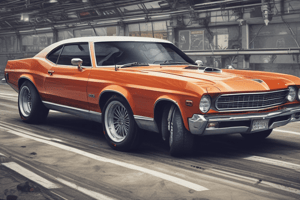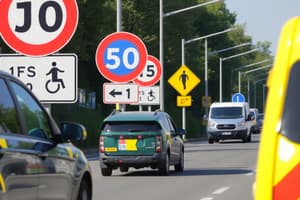Podcast
Questions and Answers
Which of the following is classified as a water vehicle?
Which of the following is classified as a water vehicle?
- Ship (correct)
- Helicopter
- Bicycle
- Car
What type of vehicle is primarily used for the transportation of goods?
What type of vehicle is primarily used for the transportation of goods?
- Airplane
- Container ship (correct)
- Train
- Ambulance
Which of the following is an example of a human-powered vehicle?
Which of the following is an example of a human-powered vehicle?
- Electric scooter
- Car
- Bicycle (correct)
- Submarine
Identify the pattern that describes the sequence 2, 4, 6, 8, 10.
Identify the pattern that describes the sequence 2, 4, 6, 8, 10.
Which statement is true regarding even numbers?
Which statement is true regarding even numbers?
Flashcards are hidden until you start studying
Study Notes
Vehicle Classification
-
Types of Vehicles:
- Land Vehicles: Travel on roads and land.
- Examples: Cars, buses, bicycles, motorcycles, trucks.
- Water Vehicles: Travel on water bodies.
- Examples: Boats, ships, submarines.
- Air Vehicles: Travel in the sky.
- Examples: Airplanes, helicopters, hot air balloons.
- Land Vehicles: Travel on roads and land.
-
Fuel Types:
- Gasoline/Diesel: Commonly used in cars, buses, and trucks.
- Electric: Eco-friendly option, used in electric cars and scooters.
- Human-Powered: Includes bicycles and skateboards.
-
Function of Vehicles:
- Transportation of People: Cars, buses, trains.
- Transportation of Goods: Trucks, container ships.
- Emergency Services: Ambulances, fire trucks, police cars.
Number Patterns
-
Definition: A number pattern is a sequence of numbers that follow a certain rule.
-
Common Patterns:
- Counting Patterns:
- Counting by 1s: 1, 2, 3, 4, 5, ...
- Counting by 2s: 2, 4, 6, 8, 10, ...
- Counting by 5s: 5, 10, 15, 20, ...
- Counting Patterns:
-
Skip Counting:
- Counting by numbers other than 1 (like counting by 2s or 5s).
-
Even and Odd Numbers:
- Even Numbers: Numbers divisible by 2 (0, 2, 4, 6, 8, ...).
- Odd Numbers: Numbers not divisible by 2 (1, 3, 5, 7, 9, ...).
-
Creating Patterns:
- Recognizing and creating patterns with objects through addition or subtraction.
- Example patterns: 1, 3, 5, 7... (adding 2 each time).
-
Using Patterns in Transportation:
- Identifying how many wheels different vehicles have (e.g., cars have 4, bicycles have 2).
- Grouping vehicles by color or size to spot patterns.
Vehicle Classification
- Vehicles can be categorized based on how they move.
- Land Vehicles: Travel on roads and land, including cars, buses, bicycles, motorcycles, and trucks.
- Water Vehicles: Travel on water bodies, including boats, ships, and submarines.
- Air Vehicles: Travel in the sky, including airplanes, helicopters, and hot air balloons.
- Different vehicles use different fuel types, including:
- Gasoline/Diesel: Most common in cars, buses, and trucks.
- Electric: Environmentally friendly, used in electric cars and scooters.
- Human-Powered: Includes bicycles and skateboards.
- Vehicles serve various functions, including:
- Transporting People: Cars, buses, trains.
- Transporting Goods: Trucks, container ships.
- Emergency Services: Ambulances, fire trucks, police cars.
Number Patterns
- A number pattern is a sequence of numbers following a specific rule.
- Common Patterns:
- Counting Patterns:
- Counting by 1s: 1, 2, 3, 4, 5...
- Counting by 2s: 2, 4, 6, 8, 10...
- Counting by 5s: 5, 10, 15, 20...
- Skip Counting: Involves counting by numbers other than 1, like 2s or 5s.
- Even and Odd Numbers:
- Even Numbers: Numbers divisible by 2 (0, 2, 4, 6, 8...).
- Odd Numbers: Numbers not divisible by 2 (1, 3, 5, 7, 9...).
- Counting Patterns:
- Creating Patterns:
- Involves recognizing and creating patterns with objects through addition or subtraction.
- Example: 1, 3, 5, 7... (adding 2 each time).
- Using Patterns in Transportation:
- Identify the number of wheels different vehicles have (e.g., cars have 4, bicycles have 2).
- Group vehicles by color or size to observe patterns.
Studying That Suits You
Use AI to generate personalized quizzes and flashcards to suit your learning preferences.





